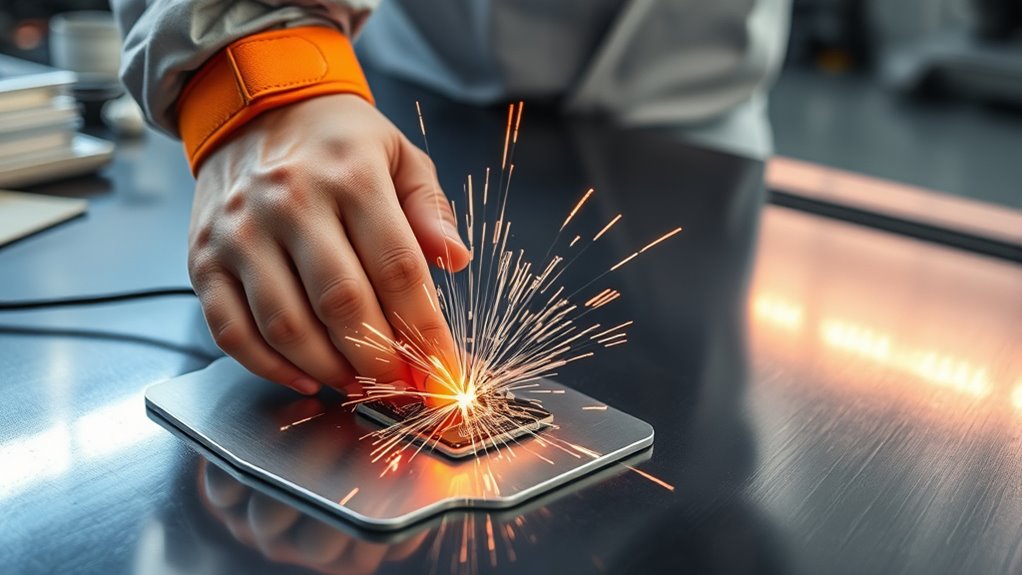To control static electricity effectively, you need to guarantee proper grounding of equipment, work surfaces, and personnel. Use grounding straps connected to a reliable ground point, and check all connections regularly for corrosion or looseness. Incorporate grounding mats and ionization systems for added protection, especially around non-conductive materials. Consistently maintaining these practices reduces static buildup and safety risks. Keep everything properly grounded, and you’ll build a safer, static-free environment—more details help you master the steps involved.
Key Takeaways
- Establish and regularly verify grounding connections for equipment, work surfaces, and personnel to safely dissipate static charges.
- Use wrist straps connected to a grounded point to prevent static buildup on personnel.
- Implement ionization systems alongside grounding for effective neutralization of static in non-conductive environments.
- Maintain static control tools and conduct ongoing training to ensure proper grounding procedures and safety protocols.
- Inspect grounding systems frequently for damage or corrosion to ensure continuous static dissipation effectiveness.

Have you ever wondered how to prevent static electricity from damaging sensitive equipment or causing dangerous sparks? It all comes down to understanding electrostatic discharge (ESD) and applying proper grounding techniques. ESD happens when built-up static electricity suddenly discharges, often damaging delicate electronic components or igniting flammable substances. To protect yourself and your equipment, you need to control static buildup and safely redirect any charges that accumulate. Implementing grounding techniques is your first line of defense. They involve creating a direct electrical connection between the equipment and the earth, allowing static charges to dissipate safely. When you properly ground tools, work surfaces, and personnel, you markedly reduce the risk of an ESD event. For example, wearing grounded wrist straps ensures that any static charge on your body is immediately grounded through a low-resistance connection. Always verify that your wrist strap is properly connected to a grounded point before handling sensitive components. Similarly, using grounded mats on workbenches provides a static-free surface, preventing static from transferring onto parts during assembly or repair. It’s also essential to confirm that all equipment and workstations are interconnected with a common ground point. This prevents potential differences between different conductive surfaces, which can cause static charges to jump unexpectedly. Regularly inspecting grounding connections for corrosion, looseness, or damage helps maintain effective ESD protection. If you notice any issues, fix them immediately to keep your static control measures reliable. In environments where static is particularly problematic, consider implementing ionization systems. These devices neutralize static charges in the air, especially around non-conductive materials that don’t easily dissipate static. Combining ionization with grounding techniques creates a holistic approach to static control. Remember, static control isn’t a one-time effort—it’s an ongoing process. Regular training ensures everyone understands the importance of grounding procedures and follows them consistently.
Frequently Asked Questions
How Often Should Grounding Systems Be Inspected?
You should inspect your grounding systems at least annually to guarantee they remain effective. Following a regular maintenance schedule helps catch corrosion, loose connections, or damage early. However, if your environment is highly static-prone or industrial, more frequent inspections, such as quarterly, might be necessary. Consistently checking your grounding system safeguards against static electricity buildup and ensures safety and compliance with industry standards.
Can Static Electricity Damage Sensitive Electronics?
Yes, static electricity can damage sensitive electronics, much like a sudden lightning strike. Electrostatic discharge (ESD) can fry delicate components instantly. Using proper grounding techniques helps dissipate static safely, preventing ESD from causing harm. You should always guarantee your grounding methods are effective and well-maintained, especially in environments with sensitive electronics. This proactive approach keeps static charges from becoming silent but deadly threats to your equipment.
Are There Specific Materials Best for Static Control?
Yes, certain materials are best for static control. When selecting materials, focus on static dissipative options like specialized mats, wrist straps, and clothing that effectively reduce static buildup. These materials allow static charges to safely dissipate instead of accumulating, protecting sensitive electronics. Always choose products designed for static control, ensuring they meet industry standards for static dissipative properties, and integrate them into your workspace for ideal protection.
What Are Common Mistakes in Grounding Implementations?
Imagine a factory where static sparks caused costly damages; improper grounding was to blame. A common mistake is believing grounding myths, like thinking any wire works. You must guarantee proper grounding practices, avoiding shortcuts that weaken static vs grounding effectiveness. Always verify connections, use correct materials, and follow standards to prevent static buildup. Poor implementation can lead to dangerous static discharge, so don’t assume all grounding methods are equal—accuracy matters.
How Does Humidity Affect Static Electricity Buildup?
Humidity levels directly impact static charge buildup; higher humidity reduces static electricity, while lower humidity increases it. When the air is dry, static charges accumulate more easily because moisture helps dissipate static. You should monitor humidity levels and maintain them around 40-60% to minimize static buildup. This way, you prevent static-related issues and protect sensitive electronics or materials from static damage.
Conclusion
By properly grounding yourself and controlling static, you act like a shield against unseen sparks that can cause harm. Imagine walking through a storm, lightning striking nearby, yet you stay safe because of a sturdy umbrella. Just as that umbrella protects, good grounding safeguards your equipment and people. Remember, neglecting these practices is like leaving your umbrella behind in a storm—you’re vulnerable. Stay grounded and keep static in check to guarantee safety and reliability every day.










